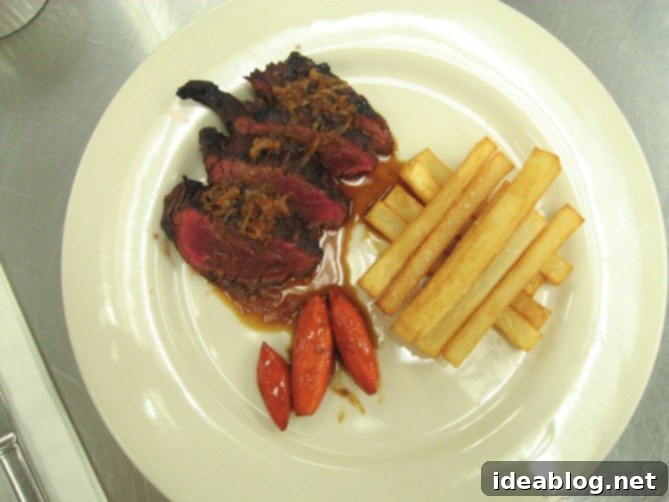Culinary School Day 16: Mastering French Cuisine with Hanger Steak, Pommes Frites, and Classic Puff Pastry
As our journey through Phase I of culinary school progresses, we’re steadily transitioning from lighter fare like vegetables and delicate soups to more substantial proteins and rich, fulfilling meals. Today, Day 16, marked a significant milestone, introducing us to an array of foundational French cooking techniques and deeply flavorful dishes. While our instructors heralded it as one of the best meals of Phase I, the sheer richness of the dishes tested my energy levels and stomach capacity, presenting a delightful challenge.
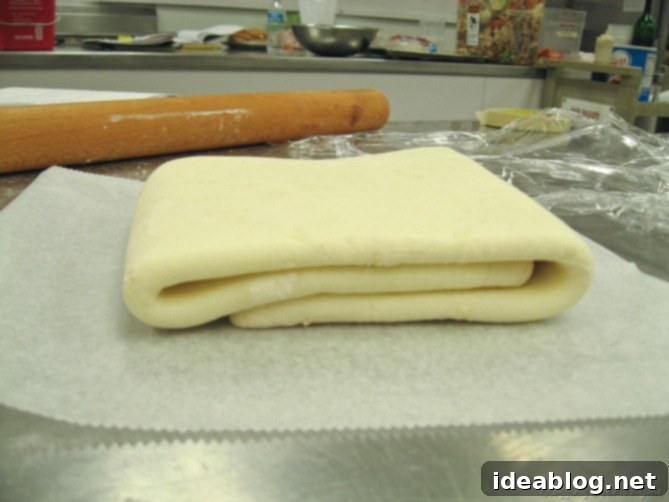
A Deep Dive into Rich Flavors and New Techniques
Day 16 will forever be etched in my memory as the day we truly embraced the art of incorporating as much flavor, fat, and butter into one meal as humanly possible, all while learning critical new techniques. This intensive session saw us baking delicate puff pastry, which we diligently prepared the day prior, utilizing the deep fryer for the very first time, and grilling meat to perfection – each a significant learning experience.
The Star of the Show: Grilled Hanger Steak with Shallot-Red Wine Vinegar Sauce
Our main course for the day was the exquisite L’ONGLET GRILLE A L’ECHALOTE, or Grilled Hanger Steak with Shallot-Red Wine Vinegar Sauce. This marked our inaugural experience with hanger steak, a distinct and flavorful cut of beef sourced from the plate primal near the diaphragm. Each cow yields only one hanger steak, making it a prized and sought-after cut, celebrated for its robust flavor. Despite its inherent toughness, it can be cooked with the finesse typically reserved for tenderloin. The key, however, lies in achieving a perfect rare to medium-rare doneness to prevent it from becoming dry and stringy.
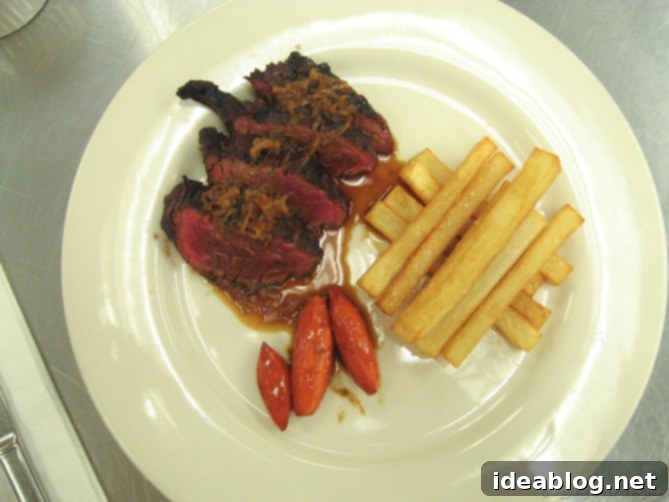
Plated Perfection: Pommes Frites, Hanger Steak & Tourneed Glazed Carrots (my two creations are proudly displayed on the right!)
Mastering the Art of Searing and Finishing Steak
To achieve the ideal texture and juiciness for our hanger steak, we employed a two-stage cooking method: an initial sear on the grill followed by a finish in the oven. This technique is crucial for several reasons:
- Achieving the Perfect Crust: Searing the steak on both sides over very high heat on the grill creates that desirable chewy, crispy outer crust known as the Maillard reaction. However, continuous grilling can lead to moisture loss with each flip, resulting in dry and tough meat.
- Ensuring Internal Moisture: Moisture naturally migrates away from direct heat. By transferring the seared steak to an oven, which provides consistent heat from all directions, we gently coax the internal moisture back towards the center of the meat. This finishing step ensures the steak remains incredibly flavorful, tender, and moist throughout.
- The Importance of Resting: The high temperatures in the oven create significant internal pressure within the meat, trapping juices. It is paramount to rest the meat before slicing. If sliced immediately, the trapped juices, under high pressure, will immediately escape, leaving the steak dry. Resting allows the internal pressure to equalize, redistribute the juices evenly, and ensure the meat remains succulent and tender. A general rule of thumb is to rest meat for approximately one-third of its total cooking time!
Classic Accompaniments: Hand-Cut Pommes Frites
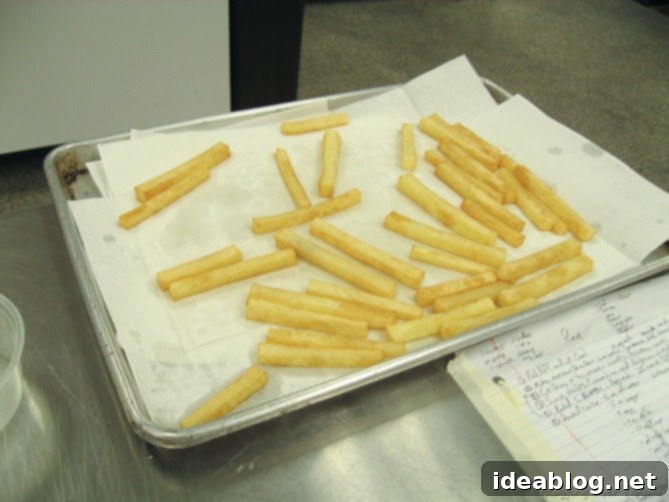
No French steak frites experience is complete without perfectly cooked French fries. Each table meticulously prepared hand-cut POMMES FRITES. The process begins with squaring the potatoes and then expertly cutting them into uniform batons, roughly 1/2-inch thick matchsticks, ensuring even cooking.
The secret to truly great fries lies in a two-stage frying method:
- First Fry (Cooking Stage): The potatoes are initially fried at a lower temperature of 325 degrees Fahrenheit. This crucial stage cooks the potatoes thoroughly from the inside without allowing them to gain significant color. They emerge tender and soft.
- Second Fry (Crisping and Browning Stage): Just before service, the fries undergo their second immersion in oil, this time at a higher temperature of 375 degrees Fahrenheit. This quick second fry is solely dedicated to achieving that classic golden-brown color and irresistible crispy texture that defines a perfect French fry.
The Tangy Complement: L’Echalote Sauce
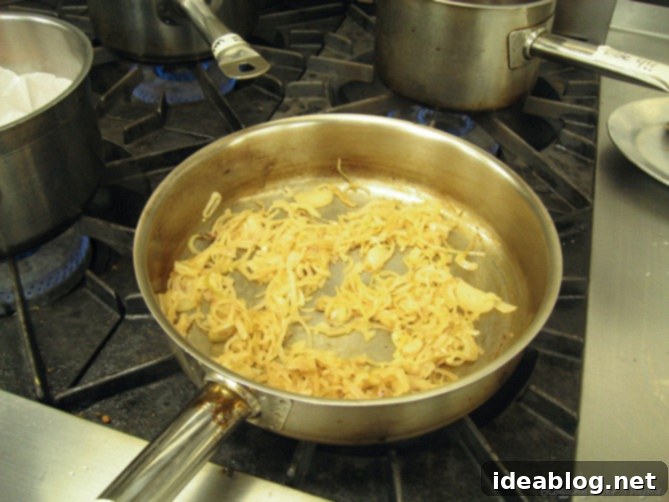
To perfectly complement our rich hanger steak, we crafted a classic L’ECHALOTE sauce. This relatively simple yet profoundly flavorful sauce is made with beautifully caramelized shallots, a splash of vibrant red wine vinegar, and a rich veal stock. Its inherent acidity provides a wonderful counterpoint to the dense, robust flavor of the hanger steak, cutting through its richness and enhancing each bite.
Elegance in Simplicity: Glazed Tourneed Carrots
Finally, to complete our savory ensemble, we added a touch of vegetable elegance: glaceed tourneed carrots. Let me share a secret: tourneeing a carrot is considerably more challenging and intricate than tourneeing a potato. However, my diligent practice for last week’s exam proved invaluable, making this daunting task much more manageable. There’s a profound reason why chefs master the potato tournee before tackling the more delicate carrot!
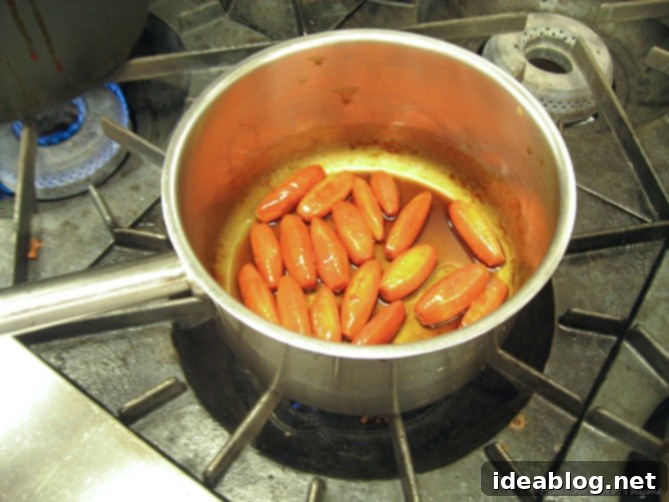
To cook these beautiful carrots, we placed them in a saucepan with a knob of butter, a pinch of salt, and a tiny amount of sugar (which aids in color development), along with veal stock, covering them about a third of the way up. We then covered the saucepan with a cartouche – a piece of parchment paper cut to fit and pressed directly onto the surface – and cooked them over very low heat until tender. Once tender, we removed the cartouche and allowed them to lightly caramelize just before serving, creating a stunning presentation and a sweet, earthy flavor.
While the act of tourneeing can be tedious and requires immense precision, I’m surprisingly finding a strange sense of relaxation in the repetitive, focused motion. It’s an unexpected enjoyment that I never thought I’d experience in the fast-paced environment of a professional kitchen.
A Journey into French Pastry: L’Allumette au Fromage
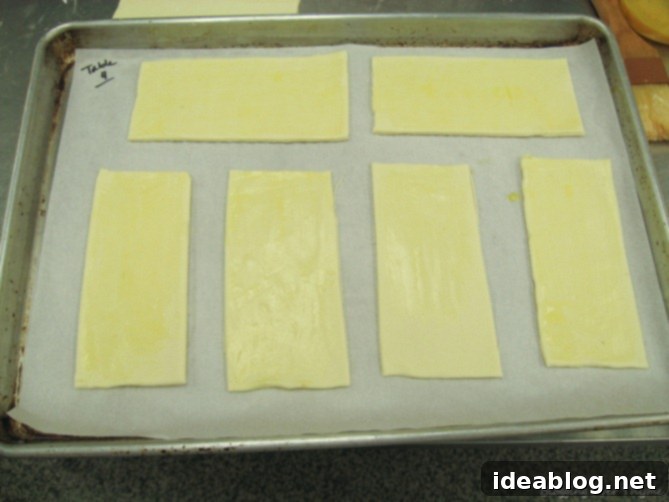
As if the rich main course wasn’t enough, we also delved into the world of French pastry, using our meticulously prepared puff pastry for the first time to create L’ALLUMETTE AU FROMAGE. This translates roughly to “puff pastry with cheese,” but the reality is far more luxurious. The cheese filling came in the form of an incredibly rich, thick, and wonderfully pipeable Mornay sauce. At its core, Béchamel is a classic French mother sauce, crafted from a roux (butter and flour) and milk.
Our version was a delightful derivative called MORNAY sauce, enhanced with the addition of both Gruyère and Parmesan cheeses. To further elevate its flavor profile, we incorporated a small amount of Dijon mustard, a touch of freshly grated nutmeg, and one egg yolk for extra richness and binding. The resulting sauce was indeed very, very thick – perfect for piping.
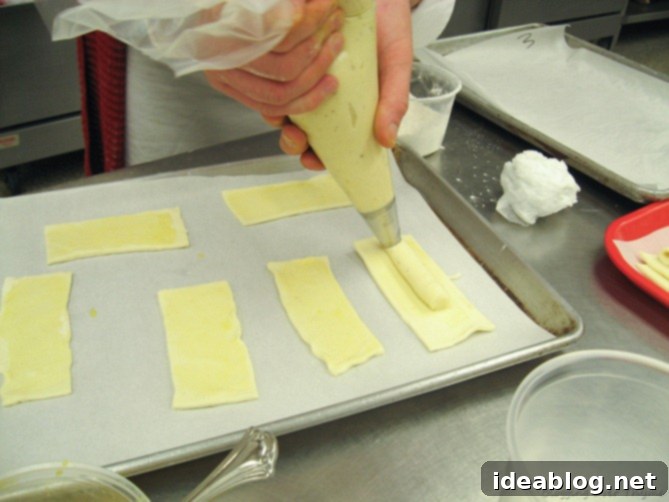
We carefully rolled and trimmed our delicate puff pastry into thin, uniform rectangles. One half of each rectangle was then brushed with an egg wash, providing a beautiful golden sheen upon baking. Onto this, we meticulously piped generous dollops of the rich Mornay sauce, ensuring an even distribution of the cheesy goodness.
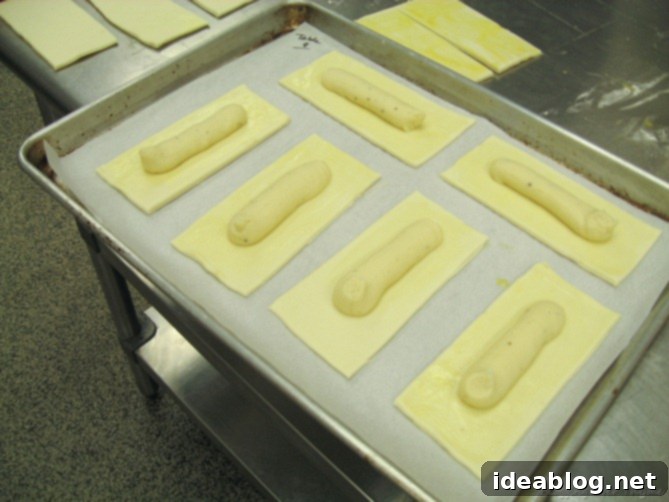
The assembly continued by carefully placing another puff pastry rectangle on top, creating a perfect sandwich for the filling. We then gently pinched around the edges of the filling to remove any trapped air pockets and create a secure seal. These masterpieces were then allowed to rest in the refrigerator, a critical step that helps the butter in the pastry firm up and prevents shrinkage during baking. Before baking, they received another brush of egg wash and were pierced with several holes to allow steam to escape, ensuring a light and airy interior.
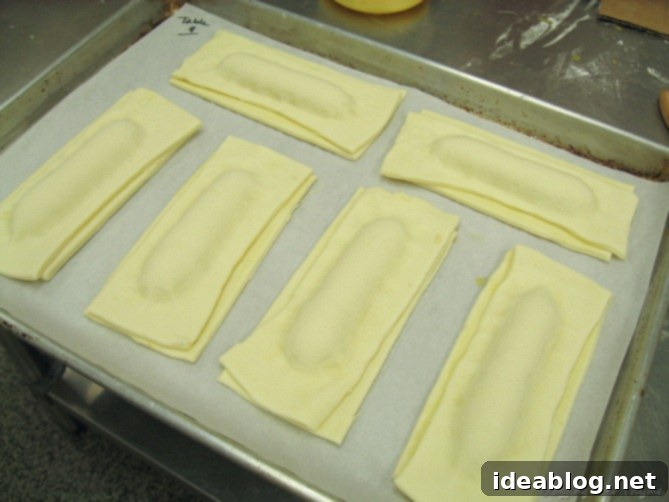
Finally, these intricate pastries were popped into a hot oven, initially baked at 400-425 degrees Fahrenheit to encourage a dramatic rise and create those incredible layers. Once they had beautifully puffed up, we reduced the temperature to approximately 325 degrees Fahrenheit, allowing them to finish baking until they were perfectly crispy and a glorious golden brown.
The transformation was astonishing – just look at how huge and voluminous they became! Puff pastry, in my opinion, truly ranks among the most ingenious concepts in baking. The person who first discovered and perfected this layering technique was undoubtedly a culinary genius.
The resulting L’Allumettes were incredibly light, yet undeniably rich, and boasted an exquisite flakiness that caused them to simply melt apart the moment they were cut. The interior revealed a luscious, creamy, and dangerously delicious cheesy sauce, making them an absolute triumph of French pastry.
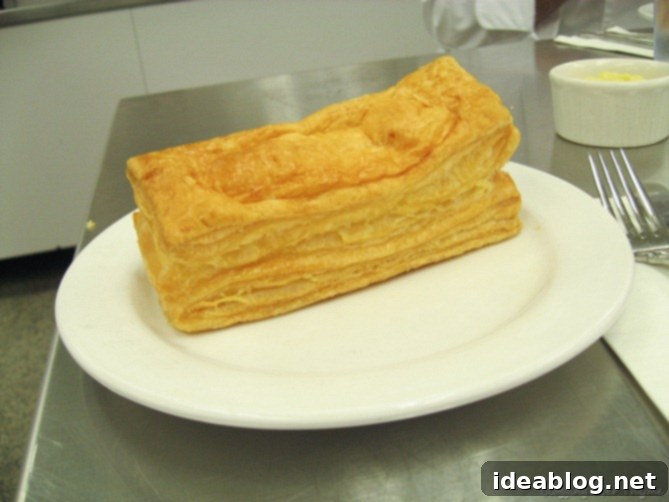
A Sweet Ending: Le Gateau Quatre-Quarts
And if all that wasn’t quite enough butter and richness for one day, we concluded our cooking session with a very basic but perfectly executed LE GATEAU QUATRE-QUARTS, more commonly known as Pound Cake. While exceptionally good and a testament to classic baking, my capacity for rich foods had reached its limit. I only managed a small bite during the demo, finding myself utterly craving plain vegetables!
I’m simply not accustomed to consuming such intensely rich foods on a daily basis, and by the end of this culinary marathon, my stomach was certainly protesting, and my energy levels were noticeably depleted. The irony wasn’t lost on me – after a day of such opulent French fare, I genuinely longed for the simple freshness of raw vegetables.
It feels a bit unfortunate that these heavier, more indulgent dishes couldn’t have been balanced with the basic, brothy vegetable soups we prepared in Week 1 & 2. However, experiencing this rich feast as a single, cohesive meal was undeniably a unique and valuable learning experience, pushing the boundaries of both my culinary skills and my palate.
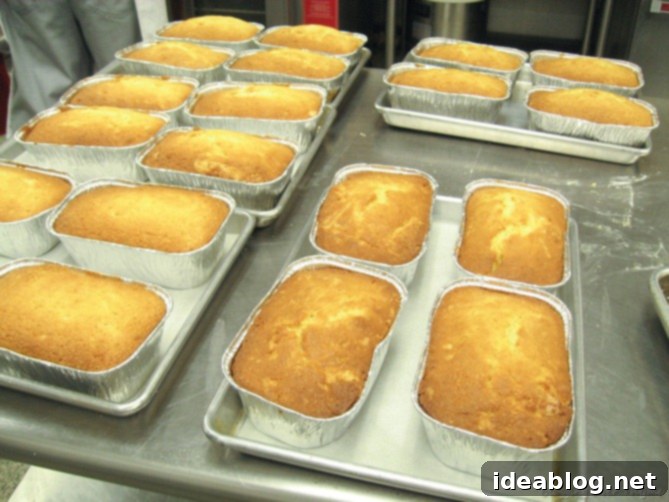
Afternoon Reflections and Lectures
Our afternoon was filled with the less glamorous but equally essential tasks of culinary school: meticulously cleaning and trimming chicken bones for future stock. This particular task, requiring sustained standing, truly highlighted just how sore and tired one can become after a long day of intense cooking. This was followed by a thorough classroom clean-up, ensuring our workspace was pristine for the next session.
The day concluded with our weekly (Tuesday) meat lecture, led by Chef Francois. Today’s fascinating discussion revolved entirely around beef – its various cuts, characteristics, and optimal uses. While incredibly informative and interesting, maintaining complete focus after indulging in such a rich and heavy meal proved to be quite the challenge.
At times, I can’t help but wonder if this demanding schedule, featuring rich meals followed by mentally taxing lectures, is a deliberate design by the instructors – perhaps a test of our resilience and ability to concentrate under even the most challenging circumstances!
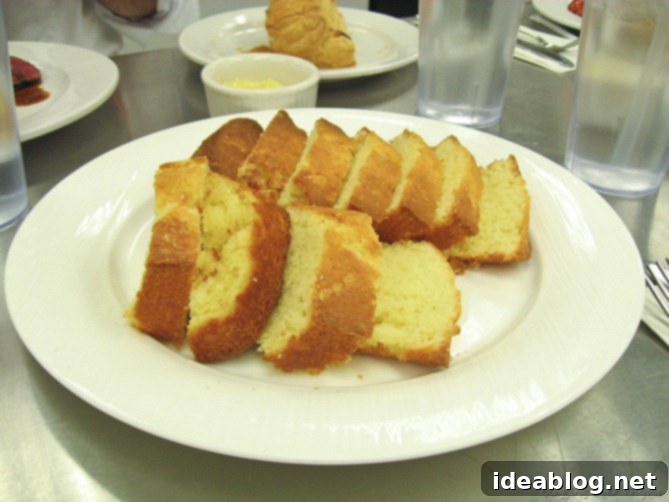
As the day draws to a close, my bed officially beckons, promising much-needed rest after this intense culinary exploration. Thank you all for your unwavering support and encouragement! Even when completely exhausted after school, I eagerly anticipate sharing the day’s adventures and lessons with you, and I truly hope you continue to enjoy following along on my culinary journey.
Stay tuned for an exciting new recipe post, which I’ll be sharing by the end of the week!
